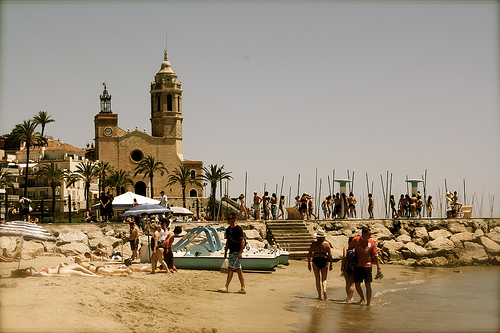Five tips to better beach pictures


1. Use UV Filters: For DSLR users, Digital Photography School recommends bringing UV filters for your lens. Not only do they protect your lens as light at the beach can be extremely bright when reflecting off the water, but they filter out atmospheric haze, making for a clearer, more natural picture. 2. Use action/sports modes: Sharpness and timing are critical when it comes to nature shots, so best to have a fast shutter speed ready to go. If you're interested in getting shots of crashing waves, best to set your camera to one of these modes as Shutterbug notes that these presets will trigger a fast shutter speed to freeze the spray. Also, its best to take these photos from a distance with a telephoto lens to protect your camera, unless you have a waterproof cover for it.
Three more after the jump.
3. Framing: I seem to always include this in all of my tips lists, but it really can't be reiterated enough. Framing can really make or break a picture sometimes. Alternative ways of thinking about framing, really thinking outside the 4 x 6 box, can produce some amazing photos. Don't just go for taking a picture with the view of looking down the beach. Focus on interesting characters, take close-ups of objects like food or sporting equipment, or simply tilt your camera in a different way than usual. Photographing a day at the beach can really be about telling a story, and at the beach, there are so many different stories. 4. Mind time of day: I'm a big fan of late afternoon, sunset and twilight pictures. Unless you have a tripod, nighttime beach photos aren't really worth the effort. I'm also much opposed to mid-day natural light, especially between Noon and 3 PM at most beaches, unless there are some spectacular cloud formations among a blue sky. There is more richness of color and availability of shadows to use later in the day. 5. Use filters when editing: Photo-editing software like Photoshop and iPhoto have a plethora of color and focus filters to take advantage of when it comes time to look through your photos. When you're shooting digitally, this is really the best time to use those Black and White and Sepia filters as you can see up close what looks good (versus doing this on the LCD screen of your camera), and you can keep the original copy of the photo untouched, in case you want to do something with it afterward. Black and white always looks classy, and it provides a quick fix for those photos that might have come out overexposed or were taken on an overcast day but you still want to keep. In iPhoto, specifically, the Antique filter provides an alternative mood to beach photography, as seen in the photo above.